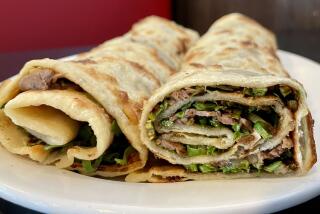Book of the week: ‘Seeds on Ice’ opens the door to an Arctic vault that could secure the future of food
- Share via
Deep inside a mountain on a Norwegian island near the Arctic Circle, at the end of a tunnel carved into the stone and permafrost, is a vault like a treasure box — a storage facility not for riches or government documents, but for seeds. What this is and how and why it came to be built in such a remote location are the subject of a new book called “Seeds on Ice: Svalbard and the Global Seed Vault” by Cary Fowler.
The seed bank made news when it opened in 2008, often pegged as a “doomsday” vault, a kind of apocalyptic filing cabinet that would help ensure the future of agriculture in case the world happened to end. The reality of the project is both more mundane and oddly optimistic. In glossy pages — the book reads like a cross between a coffee-table title and a TED talk — Fowler, an agriculture specialist and former executive director of the Global Crop Diversity Trust, describes how he and other scientists assembled a massive library of seeds as a kind of “rescue mission.” What’s being rescued of course isn’t just half a billion seeds (and counting), but our planet’s biodiversity.
There are already thousands of gene banks, collections of crop genetic material, around the world, but many are seriously underfunded and under threat — from political unrest and wars, natural disasters and climate change. The Svalbard Global Seed Vault is an attempt to safeguard those collections, by housing duplicates of as much material as it’s possible to collect in its state-of-the-art facility. Funded by the government of Norway, the Svalbard vault is the result of a partnership between Norway, NordGen (Nordic Genetic Research Center) and the Global Crop Diversity Trust, and currently houses close to 900,000 crop varieties — over 500 million seeds, stored in foil packages or glass ampoules in three underground climate-controlled vaults.
Because the Global Seed Vault isn’t open to the public, Fowler’s book is the only view of it most of us will ever get — which is why the coffee-table book format actually works. So as Fowler catalogs the history of agriculture, the long road of crop diversification and, more recently, of how many varieties have already been lost, we get stunning photography to keep us turning the pages. There’s a lot of it too: 260 photographs by Mari Tefre and National Geographic’s Jim Richardson, not only of the tomatoes and grain fields and test tubes of potato plants that got us here, but of the gorgeous landscape of the Arctic that surrounds the underground vault. There are also lots of pictures of the interior of the vault itself: rows and rows of black boxes, which might remind you, hilariously, of the stacks of storage boxes at the end of “Raiders of the Lost Ark.”
If the pictures of polar bears and collapsing ice shelves aren’t message enough of the timeliness of both the project and the book, Fowler also notes that the Global Seed Vault has already proved its worth. The first seed withdrawal came in 2015, when deposits that had been made from a gene bank in Syria were sent back to help re-establish the banks in the region. “Using an insurance policy is never anyone’s first choice,” writes Fowler in his book’s last pages. But thanks to forward-thinking scientists and a bunker built into the Arctic, at least we have the option.
Book of the week: “Seeds on Ice” by Cary Fowler (Prospecta Press, $45).
ALSO:
Cookbook of the week: ‘Tokyo Cult Recipes’
Cookbook of the week: ‘Big Bad Breakfast’ by John Currence
Cookbook of the week: With ‘Simple,’ Diana Henry proves again that simple is often best
More to Read
Eat your way across L.A.
Get our weekly Tasting Notes newsletter for reviews, news and more.
You may occasionally receive promotional content from the Los Angeles Times.










